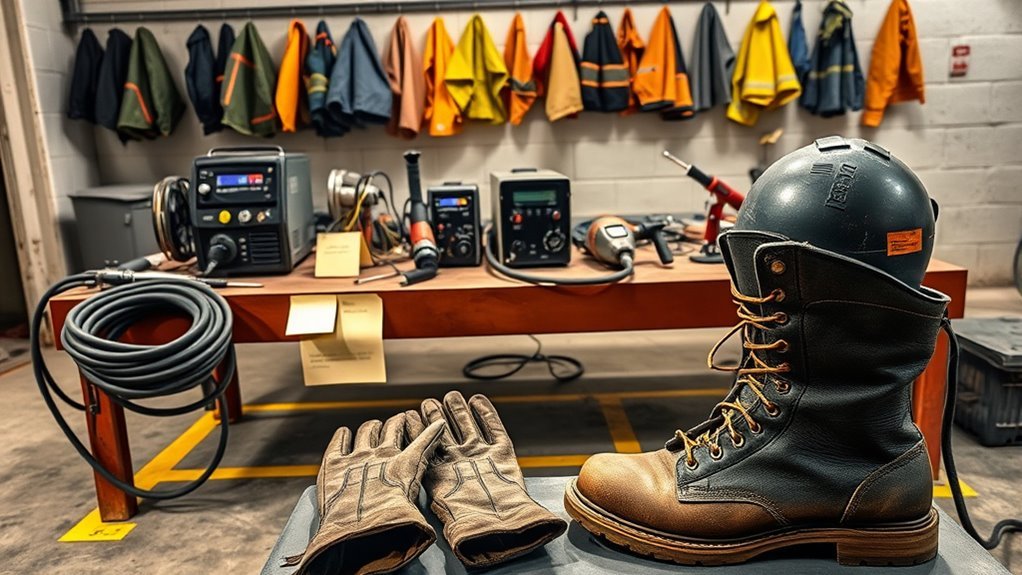You’ll typically pay between about $3,000 and $25,000 for welding school depending on the program type and length. Short certificates run a few thousand dollars, one-year diplomas fall in the $5k–$15k range, and two-year associate degrees often reach $10k–$25k. Expect another $1k–$3k for gear, tools, and test fees, plus living costs if needed. Keep going to see breakdowns, aid options, and ROI considerations.
Types of Welding Programs and Institutions

Welding training comes in several formats—trade schools, community colleges, certificate or diploma programs, associate degrees, and online courses—so you can pick the path that fits your time, budget, and career goals.
You’ll find trade schools emphasize hands-on welding techniques with intensive shop time; costs vary but programs focus on job-ready skills. Community colleges balance practical training and academics, often through two-year associate degrees that add general education and broader theory.
Certificate and diploma options deliver focused skill sets faster, useful if you want specific techniques without extra credits. Online courses give flexible theory and some virtual practice, best paired with local shop hours.
In every case, check program accreditation to guarantee credential recognition and quality of instruction.
Typical Tuition Ranges by Program Length

Most students can pick a program length that matches their schedule and budget: short certificate courses (weeks to months) run about $3,000–$10,000, one‑year diploma programs typically cost $5,000–$15,000, two‑year associate degrees usually fall between $10,000–$25,000, and four‑year bachelor’s programs can total $40,000–$100,000; overall averages land near $6,850 with some basic options starting around $2,800.
When you choose, consider welding program duration against your career goals and tuition affordability. Short certificates get you into entry roles quickly and cost least; one‑year diplomas balance time and depth; associate degrees add broader technical training and credential weight; bachelor’s degrees suit advancement into management or teaching but carry higher debt risk.
Compare program fees, financial aid, and job placement rates so you pick a length that fits your timeline and budget.
Equipment, Materials, and Safety Gear Costs

Because you’ll need your own gear and consumables for training and entry-level work, plan on budgeting for safety equipment, machines, and supplies up front.
Expect safety gear like helmets, gloves, and jackets to range widely — $100 to $500 per item — and prioritize quality for protection and longevity.
Basic welding machines run about $500–$2,000 depending on process and power.
Add consumables and hand tools ($100–$500) and certification test fees ($300–$550 each).
Altogether, plan a total equipment and materials budget of roughly $1,000–$3,000 for most programs.
Factor in ongoing equipment maintenance costs and periodic replacement of consumables.
Shop lists from your school to avoid unnecessary purchases and compare warranties and repair options.
Living Expenses and Additional Fees to Budget For

Plan on budgeting an extra $5,000–$15,000 per academic year for living expenses, depending on where you live and how frugal you are.
You’ll need clear budgeting strategies and cost saving tips to cover rent, utilities, food, and transport while in school. Don’t forget one-time and recurring program fees that raise your total cost.
- Safety gear (helmet, gloves, jacket): $100–$500
- Certification tests: $300–$550 each
- Books and supplies: $100–$500 per year
- Admission and administrative fees: around $100
- Transportation and miscellaneous living costs: variable within the $5k–$15k range
Track expenses, prioritize essentials, and use cost saving tips like shared housing and bulk groceries.
Financial Aid, Scholarships, and Grants Available

You can lower your out-of-pocket cost by combining federal grants and loans, which often offer low interest and flexible repayment.
Look for industry scholarships from professional associations and companies that target welding students.
Also check school-based aid programs—many schools, including MTI, participate in federal aid and offer institutional awards.
Federal Grants & Loans
Several federal grants, loans, and veteran benefits can lower your welding-school bills and make training more affordable. You should explore federal assistance programs and financial aid options early to combine sources and reduce out-of-pocket cost.
Federal grants provide nonrepayable aid for tuition. Federal student loans offer lower interest and flexible repayment to bridge gaps. The GI Bill® supports veterans and eligible dependents for welding programs. Research and apply to multiple programs to optimize funding and minimize debt.
- Apply for federal grants (Pell Grant and others) to cover tuition portions.
- Compare federal student loans for lower rates and repayment plans.
- Use GI Bill® benefits if you qualify for significant support.
- Contact your school’s financial aid office for package guidance.
- Track deadlines and required documents for each aid source.
Industry Scholarships Available
Many welding schools, industry groups, and companies offer scholarships that can cut your tuition and living costs—so start identifying opportunities early and apply widely.
You should track options from trade programs, the American Welding Society, MTI, private companies, and professional associations. Check each listing for scholarship eligibility — some target high school seniors, others require enrollment in accredited programs or competition placement.
Attend competitions like the Annual High School Welding Competition; they often grant awards that boost funding and your resume.
Create a calendar of application deadlines, required documents, and contact persons. Prepare a concise resume, letters of recommendation, and work samples or competition results.
Apply to multiple sources to maximize chances and reduce your out-of-pocket costs.
School-Based Aid Programs
Although managing costs can feel overwhelming, welding schools and related programs offer several aid options to make training affordable. You can tap into school benefits and external financial support to lower tuition and living expenses.
Many schools help you apply for federal grants and low-interest loans, while specific institutions like MTI award scholarships to promising high school seniors. Veterans can use the GI Bill® for eligible programs. You’ll often combine grants, scholarships, and loans to maximize aid and cut net costs.
- Federal grants and low-interest student loans coordinated by your school
- School-specific scholarships (example: MTI awards for seniors)
- Professional association scholarships (American Welding Society)
- GI Bill® benefits for veterans and dependents
- Private company and foundation grants and awards
Payment Plans, Loans, and Veteran Benefits
If you need help covering upfront costs, welding schools often let you spread tuition into smaller payments—sometimes aligned with 7- or 10-week terms—so you can manage cash flow over the program.
You’ll find payment flexibility through school plans and should ask about schedules, fees, and penalties.
Check loan options: some schools participate in federal student loan programs that offer lower interest and flexible repayment, but not every institution qualifies.
Some schools accept federal student loans with lower interest and flexible repayment—confirm the institution’s eligibility first
Pursue scholarships and grants first since they don’t require repayment; combine those with loans only as needed.
If you’re a veteran or a dependent, GI Bill® benefits can cover tuition and other eligible expenses—confirm program approval and certification with the school’s VA certifying official before enrolling.
Certification, Licensing, and Testing Costs
You can manage tuition payments and still face separate charges for certification and licensing that affect your total cost.
You’ll likely pay $300–$550 per certification test, often outside tuition. Even in states without licensing like Illinois or Missouri, certification benefits include stronger job prospects.
The American Welding Society Certified Welder exam is widely recognized and may be required by employers in specialized fields. Some schools, such as MTI, offer extra certification options that add fees.
Plan for ongoing costs if you pursue advanced credentials or continuing education.
- Expect $300–$550 per certification test, not usually in tuition
- Certification benefits: better hiring chances, access to specialty work
- Know testing requirements for AWS exams
- Some schools charge extra for added certs
- Budget for future recertification and advanced courses
Return on Investment: Career Paths and Earning Potential
Because welding training typically costs $5,000–$30,000, you’ll want to weigh that investment against clear career outcomes: median pay was $47,540 in May 2022, and welders with advanced certifications or niche skills—like aerospace or underwater welding—can command considerably higher wages and more stable placement in industries such as oil and gas, shipbuilding, and manufacturing.
You’ll find predictable returns if you target regions with manufacturing or construction density and pursue certifications that match employer demand.
Plan for career advancement by mapping entry-level roles to specialized tracks (pressure piping, robotic welding, underwater). Skill specialization boosts pay and placement rates.
Evaluate program placement statistics, local industry demand, and certification costs to estimate time-to-payoff and choose the training that maximizes long-term earning potential.
Frequently Asked Questions
How Long Does It Take to Find a Welding Job After Graduation?
You’ll typically find a welding job within a few weeks to six months after graduation. Use job placement services and graduate support, network with employers, polish your resume, and take certifications to speed up hiring.
Do Employers Prefer Specific Welding School Brands?
Some employers do prefer specific welding school brands; you’ll find welding school reputation influences employer preferences, but practical skills, certifications, and experience usually matter more, so focus on demonstrable abilities and relevant industry credentials.
Can I Specialize in Exotic Welding Materials Like Titanium?
Yes — you can specialize in exotic materials like titanium welding. You’ll need targeted courses, certification, hands-on practice, and industry experience. Pursue apprenticeships, advanced training, and safety protocols to qualify for aerospace, medical, or high-performance fabrication roles.
Are Apprenticeship Opportunities Included With Tuition?
Yes — many schools include apprenticeship programs as part of the tuition breakdown; you’ll see structured hours, hands-on shop time, and employer placements listed, so you can plan financing and track practical experience alongside classroom costs.
What Insurance or Liability Coverage Should I Have as a Student?
You should carry student liability insurance and explore coverage options like personal accident, renters (if housing), and limited professional liability via school or third-party plans; check apprenticeship requirements and get documentation before starting hands-on welding.
Conclusion
Choosing welding school is an investment that pays off: median entry-level welders in the U.S. earn about $22 per hour, so even a $5,000–$15,000 program can pay back fast. Factor tuition, gear, living costs, and certification fees when comparing programs, and pursue grants, payment plans, or VA benefits to lower upfront costs. Prioritize hands-on labs and industry certifications to maximize ROI and move quickly into higher-paying specialties.


